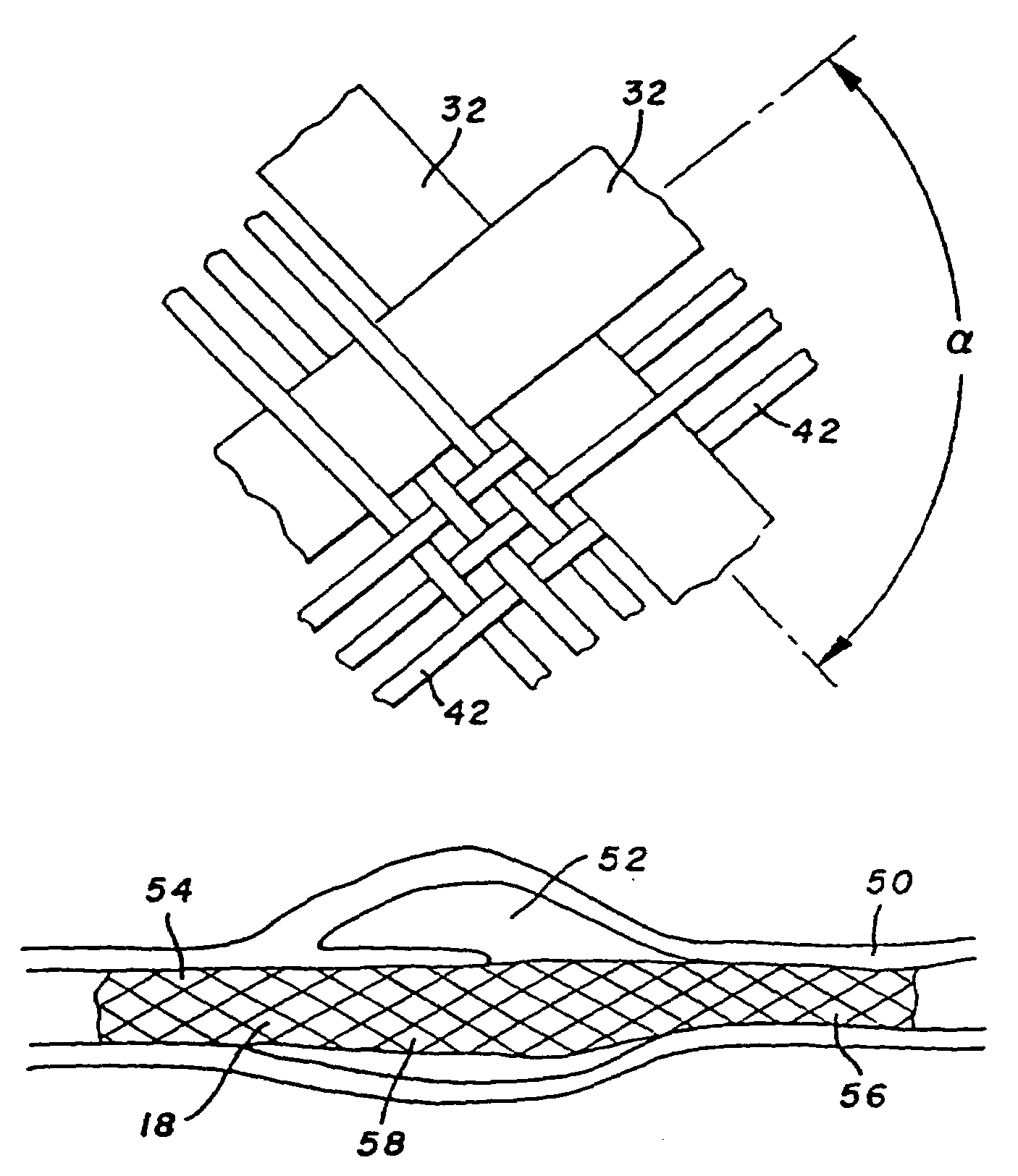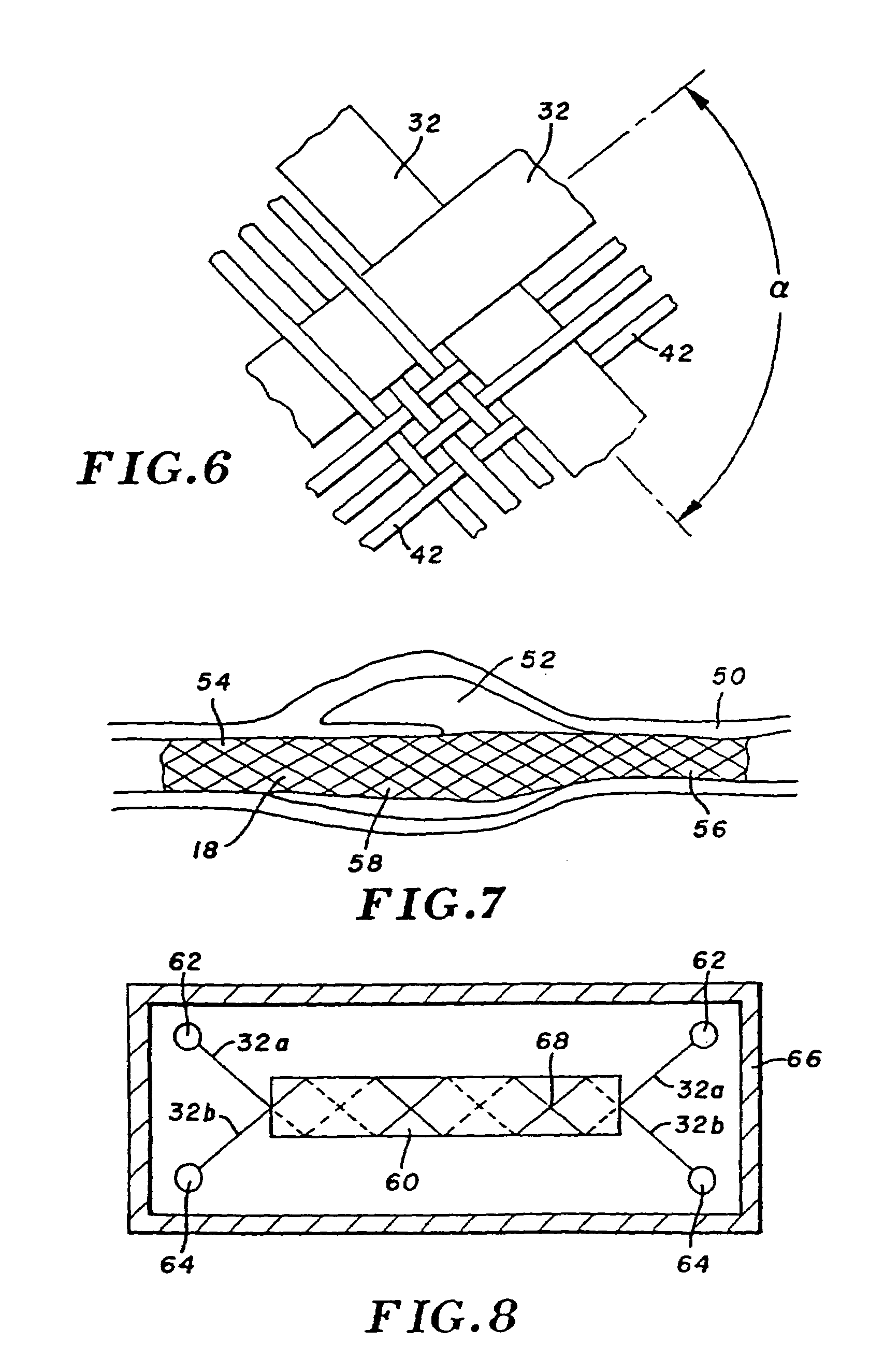Three-dimensional braided covered stent
a three-dimensional, covered stent technology, applied in the field of body implantable devices, can solve the problems of limiting the types of materials that can be interbraided into the device, difficult to provide a device, etc., to achieve the effect of enhancing radial self-expansion, facilitating the confinement of the latticework, and reducing manufacturing costs
- Summary
- Abstract
- Description
- Claims
- Application Information
AI Technical Summary
Benefits of technology
Problems solved by technology
Method used
Image
Examples
example 1
[0078]The bobbins of the carrier assembly (FIG. 13) are loaded with two hundred and twenty-four textile strands of polyester, each being 70 denier and composed of forty-seven filaments. More particularly, all of the bobbins in sets 80, 82, 86 and 88 are loaded with the polyester yarn. These textile strands also are loaded onto thirty-two of the bobbins in central set 84. Of the remaining sixteen bobbins, eight bobbins installed on carriers in the clockwise direction, and eight bobbins installed in the counterclockwise direction, are loaded with sixteen structural strands. The structural strands are arranged symmetrically, in that in each direction, every third bobbin is loaded with one of the structural strands. Each structural strand is an Elgiloy wire having a diameter of 0.0047 inches (0.12 mm). The strands are braided onto an 8 mm diameter round mandrel, with the braider operated to determine a braid angle of 110°. The braid is formed to an adequate length, then removed from the...
example 2
[0080]As in Example 1, the textile strands are 70 denier polyester yarns composed of forty-seven filaments. One hundred and sixty-eight of the polyester yarn textile strands are loaded (FIG. 14) as follows: onto all the bobbins of outer set 88, its adjacent set 86, and set 82. Twenty-four bobbins of central set 84 also are loaded with the polyester yarn. The remaining twenty-four bobbins of the central set are loaded with Elgiloy wire, again having a diameter of 0.0047 inches. Twelve of these bobbins are installed in the clockwise direction, and twelve in the counterclockwise direction, with every second bobbin being wound with a structural strand. All bobbins of inner set 80 are loaded with a 70 denier collagen fiber. The strands are braided onto an 8 mm diameter round mandrel, with the braider operated to determine a braid angle of 110°.
[0081]The result is a tubular, three-dimensionally braided structure of the polyester yarn and metal monofilaments, with an inner layer of fibers ...
example 3
[0082]As in Example 1, all the bobbins in sets 80, 82, 86 and 88 are loaded with the textile strands, each being a 70 denier polyester yarn composed of forty-seven filaments. In set 84 corresponding to a central layer of the finished structure, twenty-four of the carrier bobbins likewise are loaded with the polyester multifilament yarn. The remaining twenty-four bobbins are loaded with a 0.0047 inch diameter Elgiloy wire. In this case, all twenty-four bobbins installed in the clockwise direction are loaded with the Elgiloy wire. The strands are braided onto an 8 mm diameter round mandrel, with the braider operated to determine a braid angle of 110°. This arrangement is not illustrated.
[0083]The result is a tubular three-dimensionally braided structure of the polyester yarn and metal monofilaments. The wire latticework consists of spirals wound in the clockwise direction.
PUM
| Property | Measurement | Unit |
|---|---|---|
| braid angle | aaaaa | aaaaa |
| weight percent | aaaaa | aaaaa |
| weight percent | aaaaa | aaaaa |
Abstract
Description
Claims
Application Information
 Login to View More
Login to View More - R&D
- Intellectual Property
- Life Sciences
- Materials
- Tech Scout
- Unparalleled Data Quality
- Higher Quality Content
- 60% Fewer Hallucinations
Browse by: Latest US Patents, China's latest patents, Technical Efficacy Thesaurus, Application Domain, Technology Topic, Popular Technical Reports.
© 2025 PatSnap. All rights reserved.Legal|Privacy policy|Modern Slavery Act Transparency Statement|Sitemap|About US| Contact US: help@patsnap.com



